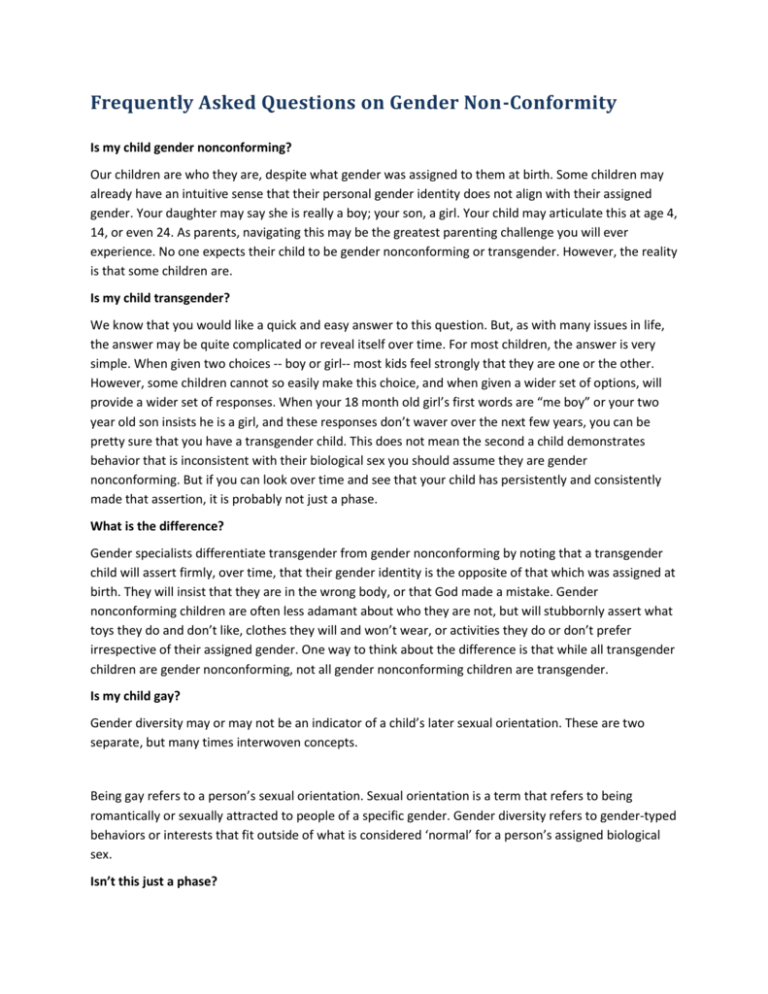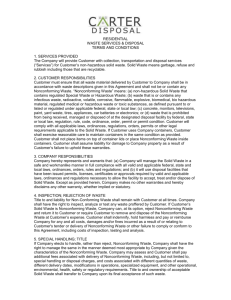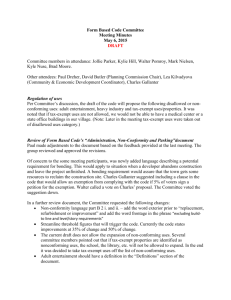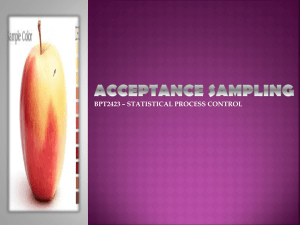Frequently Asked Que.. - Bridges to Opportunity
advertisement

Frequently Asked Questions on Gender Non-Conformity Is my child gender nonconforming? Our children are who they are, despite what gender was assigned to them at birth. Some children may already have an intuitive sense that their personal gender identity does not align with their assigned gender. Your daughter may say she is really a boy; your son, a girl. Your child may articulate this at age 4, 14, or even 24. As parents, navigating this may be the greatest parenting challenge you will ever experience. No one expects their child to be gender nonconforming or transgender. However, the reality is that some children are. Is my child transgender? We know that you would like a quick and easy answer to this question. But, as with many issues in life, the answer may be quite complicated or reveal itself over time. For most children, the answer is very simple. When given two choices -- boy or girl-- most kids feel strongly that they are one or the other. However, some children cannot so easily make this choice, and when given a wider set of options, will provide a wider set of responses. When your 18 month old girl’s first words are “me boy” or your two year old son insists he is a girl, and these responses don’t waver over the next few years, you can be pretty sure that you have a transgender child. This does not mean the second a child demonstrates behavior that is inconsistent with their biological sex you should assume they are gender nonconforming. But if you can look over time and see that your child has persistently and consistently made that assertion, it is probably not just a phase. What is the difference? Gender specialists differentiate transgender from gender nonconforming by noting that a transgender child will assert firmly, over time, that their gender identity is the opposite of that which was assigned at birth. They will insist that they are in the wrong body, or that God made a mistake. Gender nonconforming children are often less adamant about who they are not, but will stubbornly assert what toys they do and don’t like, clothes they will and won’t wear, or activities they do or don’t prefer irrespective of their assigned gender. One way to think about the difference is that while all transgender children are gender nonconforming, not all gender nonconforming children are transgender. Is my child gay? Gender diversity may or may not be an indicator of a child’s later sexual orientation. These are two separate, but many times interwoven concepts. Being gay refers to a person’s sexual orientation. Sexual orientation is a term that refers to being romantically or sexually attracted to people of a specific gender. Gender diversity refers to gender-typed behaviors or interests that fit outside of what is considered ‘normal’ for a person’s assigned biological sex. Isn’t this just a phase? For some children, expressing gender nonconformity may be a phase; for others, it is not. The longer a child has identified as cross-gendered, the easier it becomes for a parent to answer this question themselves. The answer may become clearer over time. Regardless of the eventual outcome, the selfesteem, mental well-being, and overall health of a gender nonconforming child relies heavily on receiving love, support and compassion from their parents. If your child has expressed a cross-gendered identity since early childhood, it is unlikely they will change their mind. Most people have some sense of their gender identity between the ages of two and four years old. For most, this awareness remains stable over time. Identity becomes further refined at puberty onset and when puberty is more or less completed. For children whose gender nonconforming identity has remained stable and unchanged, parents can expect this will continue throughout life. Their sense of themselves will only deepen. For example, a 12 year old child who has consistently asserted that he is a girl since the age of three will most likely remain cross-gendered throughout life. A young child who feels cross-gendered may change their mind. The most common time for this to occur is about 9-10 years old. There is insufficient research to know if these children later identify as gender nonconforming or transgender adults. So, it is unclear if this change indicates sublimation or if it was just childhood phase. Who caused this? It is common for parents to blame themselves when a child falls outside of gender norms. They ask themselves, “Is it my fault somehow?” “Where did I go wrong?” Mothers may feel they were too permissive. Fathers may be angry and refuse to accept their gender nonconforming child, especially if this child was born a boy. Gender diversity is not an illness or a result of poor parenting. It is not the result of divorce or an indication of child abuse. Gender diversity is not caused by liberal, or permissive parenting, or by a parent who secretly wished their child were the ‘opposite’ sex. It is normal. You did not cause this or do anything wrong. Current research supports the theory that gender is, to some extent, “hard-wired” in the brain from birth. How do I change it? A parent cannot cause a child to be gender nonconforming, nor can they change a child’s gender identity. It is a core sense of self. If a professional tells you that you can change your child to have a different gender identity, they are wrong. While your parenting choices will not change your child’s sense of who they are, however, they will have a profound impact on how they feel about themselves in relation to their gender identity. I am confused (what about my feelings?) Parents’ responses to their cross-gender children vary. It can be very hard to create an environment to enable children to express themselves in ways most natural to them. We may get uncomfortable, embarrassed, nervous or afraid. Feelings of denial, anger, fear, doubt, grief, and worry are normal, and part of the path to acceptance, understanding, support, pride and joy. Another common yet often unexpected feeling is that of loss. Families, parents, and siblings may feel a sense of grief at the idea they are “losing” their son or daughter, their brother or sister. Even though the child is alive and well, changing gender can elicit strong feelings of loss. We may experience periods of sadness, anger, and mourning as we (or our other children) come to terms with our child’s new identity. How can my child have no gender or a blended gender? Not all children fit neatly into a male or female gender identity, trans or otherwise. For some children, the sense of being “both” or “neither” best describes their reality. Children seeing themselves as “both” will often explain that whether with a group of girls or a group of boys, they feel “at home.” Such a child will often speak of being more of one some days and more of the other on different days. These children might best be described as fluid in their gender. One therapist reported how some of the teens coming into the practice were describing themselves as “gender Priuses; you know, hybrids!” Children who see themselves as “neither” will often speak of how regardless of whether they’re with a group of boys or girls; they feel like they don’t fit. This is not necessarily a sad feeling. They just see the kids around them and know that they are not “that.” Kids in this category often appear androgynous, and will frequently answer the question “are you a boy or a girl” by saying their name (“I’m Devon”) or by identifying themselves as animals. When asked to draw self-portraits, they will portray themselves as rainbows, or unicorns, or another symbol of their choosing. What do I do about other people in my family? As a result of our long held beliefs about gender and the immense pressures from society, it is easy to understand that conflict may occur within and between our other family members. We do not reach understanding and acceptance overnight, and we experience considerable stress as a result. We may be uncomfortable, embarrassed, nervous or afraid. We may be desperate to find and grasp “solid” answers. Our discomfort impacts the entire family. What about my other children? Sometimes the gender diversity of a family member can put a family into a sense of perpetual crisis. Because of our discomfort with gender diversity, we may unconsciously bond with our other children more than our gender nonconforming child. By doing this, we may inadvertently place the sibling in a position of having to choose loyalties to us or to their sibling—obviously not something we would want to do intentionally. Alternately, we may overly focus on the gender nonconforming child, overlooking the sibling as a result. A sibling may act out in an effort to gain our attention, possibly in ways that are hurtful to their gender nonconforming sibling. For example, the sibling may “out” or disclose personal information about the gender nonconforming child at inappropriate times or in a disrespectful manner. Gender diverse children may be teased and bullied, even by their siblings. Siblings may participate because they feel pressure from their peers to ostracize or be critical of their gender nonconforming sibling. Or, the need to defend their gender nonconforming sibling from bullying by others can put pressure on the sibling who is gender-typical. How many kids like this are there? No one knows how common gender nonconforming and transgender children are. Some gender specialists estimate that 1 in 500 children is significantly gender nonconforming or transgender. An older study based on statistics of postoperative transsexual men put the number at 1 in 20,000. The challenge of answering this question is immense. What is considered “gender nonconforming” to one researcher may not to another; many families choose not to be public about their child’s gender status, and doctors cannot do “population-based” research in the US on such issues. So at present, it is impossible to determine the actual number of transgender or gender diverse children in the US. If I allow my child to be this way won’t they be bullied or worse? Gender nonconforming or otherwise, children not fitting typical gender boxes are frequently the victims of mistreatment or even violence. This may well happen for our children too; sadly, most kids get teased about something at some point growing up. Our role as parents is to love and accept our child, and we will help them learn how to deal with teasing. We will also teach our child how to access the support needed when it feels like things are becoming unsafe. It is our job to protect our child, and we will do as much as possible to educate those around them—in our family, our community, and our child’s schools. What about the pressures to conform? Currently our society is somewhat tolerant of a certain level of masculinity in females. However, the pressures and expectations of masculinity as it is expressed in males are profound. In U.S. culture, there exists little flexibility in the boundaries of masculinity. This seems especially true if a child is born biologically male, but expresses interests or behaviors traditionally considered feminine. This pressure affects both parents, but can also mean that fathers may have a more challenging time accepting gender diversity in their child. How can I seek faith-related support? Depending on the religion or religious community, acceptance of gender nonconformity can vary tremendously. It can be helpful to take stock of your religious community’s influences. List the overt messages and messengers about gender and LGB issues, as well as how LGBT people tend to be characterized. You might well be able to identify people who you perceive as “safe.” Approach these members first about your situation and seek their counsel on how to approach to others. It is also important to remember that gender diversity cuts across all racial, cultural and religious lines. Others may be more private than you and your family, but with sensitive exploration, you will find others in your community who are more tolerant. In the process of sporting your child, you may well lose important people in your life, but more than likely you will also gain some important new people to replace them.






![Article 11 BOCC Changes REDLINE[Icon]](http://s3.studylib.net/store/data/006649436_1-a9333550dc4eb9c23d83b0b89b961822-300x300.png)




